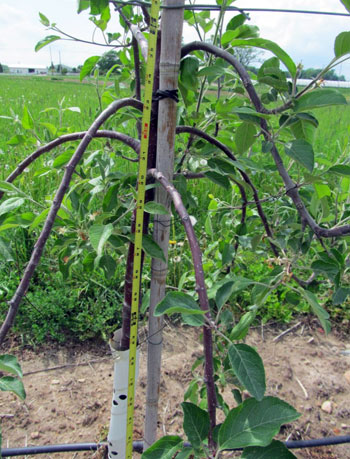Snow loads and developing apple trees for tall spindle system in Michigan
Adjust your pruning as heavy snow-load from this past winter caused many broken branches in tall spindle apple trees.
Michigan State University Extension educators recently reported that growers are having problems regarding accrued snow-load, which in many cases broke branches this winter. The weight of the snow through this past winter, which extended to heights in some cases above 36 inches, damaged branches on newly planted trees. This situation was made worse where branches, or “feathers,” were left at planting time which originated below 32 inches above ground line.
Feathers, or branches developed in the nursery, are handled by bending below the horizon in a downward angle using rubber bands or floral wire. The benefit of this process is that many of these branches will slow in linear branch growth and dominance. Secondly, spurs and flowering will be encouraged by the process when bent below 45 degree below the horizon.
However, recommendations for training have been clear to encourage growers to not allow branches beginning below about 32-36 inches. If you train branches starting below 32 inches, the distal ends of long feathers, which should not be pruned, will touch the ground and be vulnerable to herbicide damage and pests. After this winter, it is clear that these lower branches are also vulnerable to breakage from snow load.
See the images below where branches from trees established below 32 inches in 2013 were broken by this past winter’s snow-load.


Left, Tall spindle tree with branches started below 32 inches. Right, Tall spindle tree established in 2012 with branches started at 32 inches. Note there is no damage.



 Print
Print Email
Email

